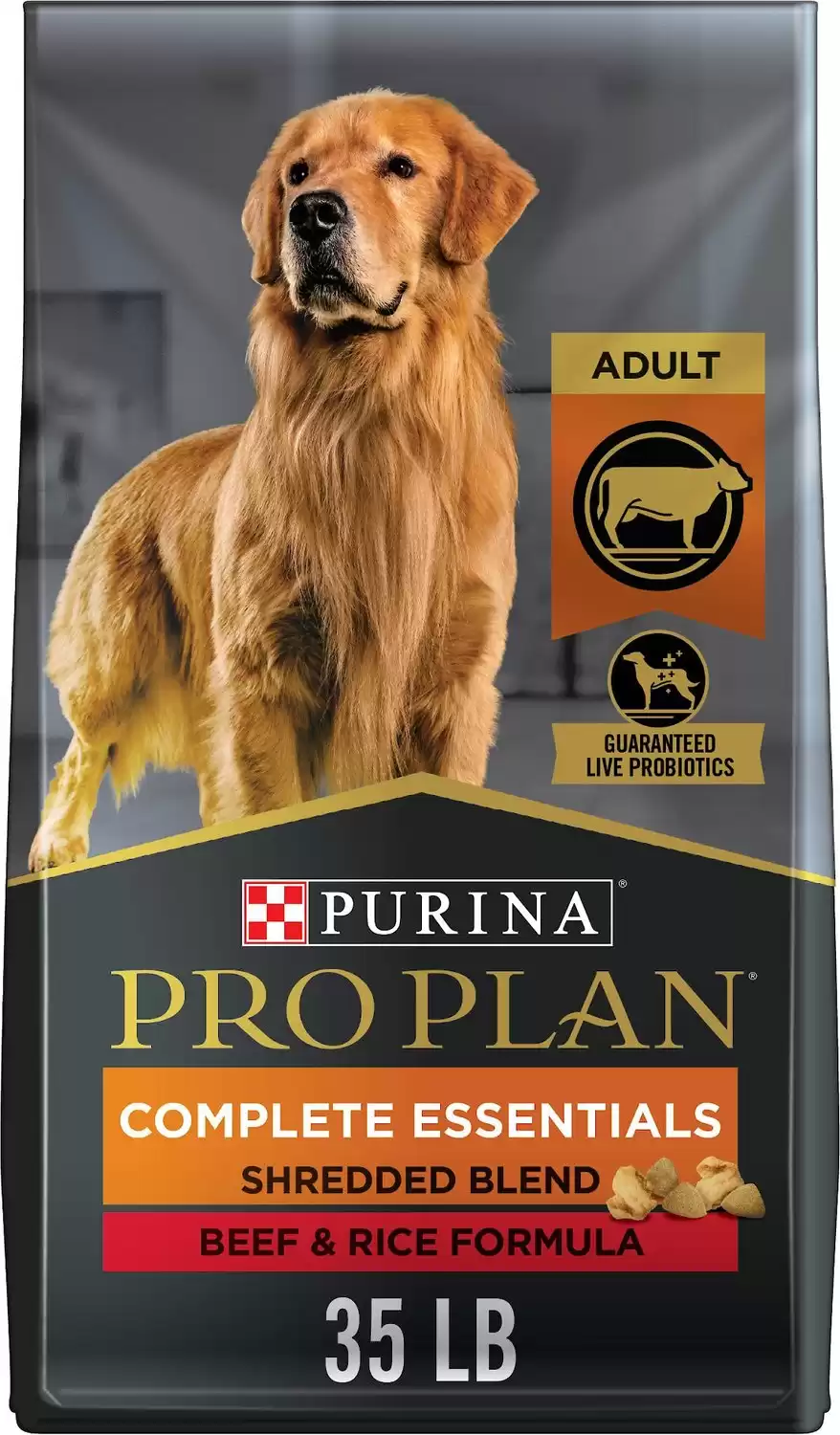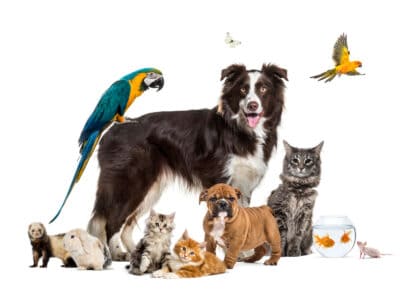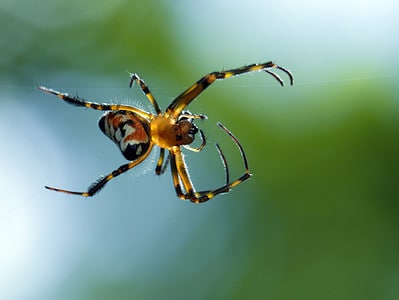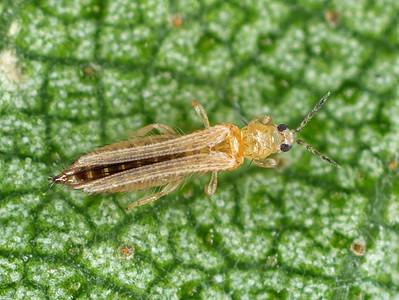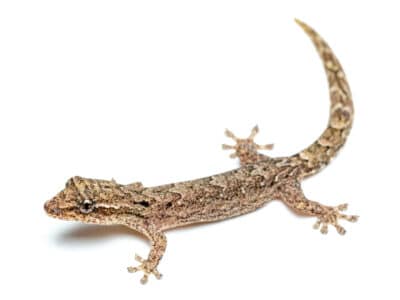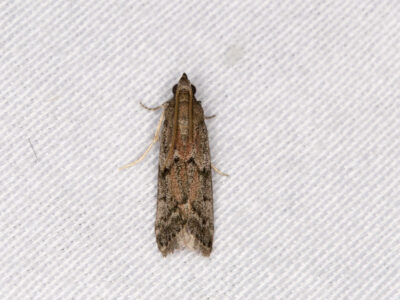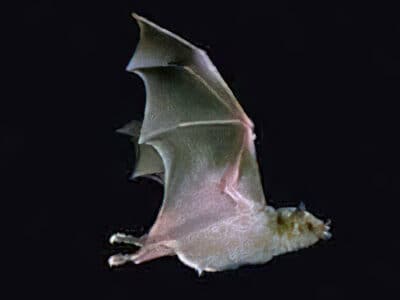Beabull
Canis lupus familiaris
An excellent companion for cats!
Advertisement
Beabull Scientific Classification
- Kingdom
- Animalia
- Phylum
- Chordata
- Class
- Mammalia
- Order
- Carnivora
- Family
- Canidae
- Genus
- Canis
- Scientific Name
- Canis lupus familiaris
Read our Complete Guide to Classification of Animals.
Beabull Conservation Status
Beabull Facts
- Prey
- rabbits
- Main Prey
- rabbits
- Name Of Young
- puppies
- Group Behavior
- Pack
- Social
- Fun Fact
- An excellent companion for cats!
- Estimated Population Size
- unknown
- Biggest Threat
- being hit by cars, dog fights
- Most Distinctive Feature
- wrinkly face
- Distinctive Feature
- deep howl
- Other Name(s)
- Beagle Bulldog Mix
- Gestation Period
- 2 months
- Temperament
- laid back
- Training
- difficult to train, stubborn, high prey and bite drive
- Age Of Independence
- 3 months
- Litter Size
- 4-6 puppies
- Habitat
- domesticated
- Diet
- Omnivore
- Average Litter Size
- 4-6 puppies
- Lifestyle
- Pack
- Social
- Favorite Food
- meat
- Type
- mammal
- Common Name
- Beagle Bulldog Hybrid
- Special Features
- wrinkly face and deep howl
- Origin
- North America
- Number Of Species
- 1
- Location
- North America
Beabull Physical Characteristics
- Color
- Multi-colored
- Skin Type
- Fur
- Top Speed
- 15 mph
- Lifespan
- 10-12 years
- Weight
- 25-45 pounds
- Height
- 12-16"
- Length
- 14-18"
- Age of Sexual Maturity
- 12 months
- Age of Weaning
- 2 months
Beabull as a Pet:
- General Health
- Energy Level
- Shedability
- Trainability
- Intelligence
- Tendency to Chew
- Size
- Family and kid friendliness
- Yappiness / Barking
- High
- Separation Anxiety
- Moderate
- Preferred Temperature
- Average climate
- Exercise Needs
- Moderate
- Friendly With Other Dogs
- High
- Pure bred cost to own
- $900+ plus annual veterinary costs
- Dog group
- Non-sporting
- Male weight
- 35-40 lbs
- Female weight
- 25-30 lbs
This post may contain affiliate links to our partners like Chewy, Amazon, and others. Purchasing through these helps us further the A-Z Animals mission to educate about the world's species.
View all of the Beabull images!
An excellent companion for cats!
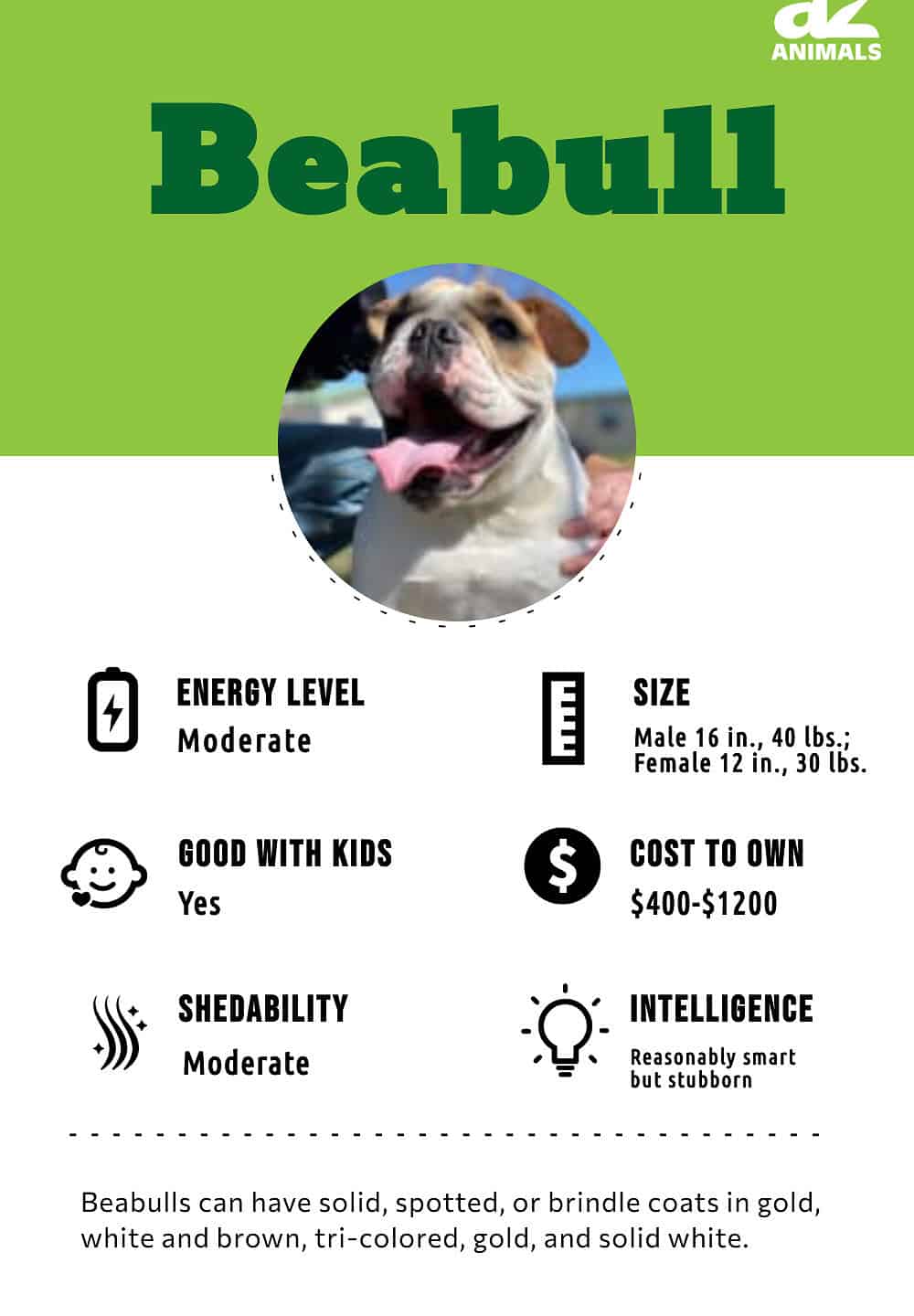
Introduction
A Beabull is the mixture of two of the most popular dog breeds, the Beagle and the Bulldog. These delightful little dogs are lovable, curious, and loyal to their families. The breed mix boasts a lineage that includes two of Europes’ oldest breeds. Beagles go back to 16th century England when they hunted deer, foxes, and rabbits. Bulldogs were originally used for bull-baiting in the 17th century.
See all of our expert product reviews.
The mixture of these two breeds has helped make Beabulls the excellent family companions that they are. These dogs have been bred primarily as family companions because of these positive traits, likely since the early 2000s. They love family members of all ages and do wonderfully with other pets.
3 Pros and Cons of Ownership
| Pros | Cons |
|---|---|
| An Adaptable Dog For All Families Beabulls get along with all members of your family, human and animal. They adapt well to multi-member and single-person households. | May Bark Or Howl A Lot Beabulls might bark or howl a lot because of their beagle ancestors, which as hounds tend to be loud. You can expect beabulls to consistently do a lot of barking when they hear something. |
| Playful Without Being Hyper These dogs love running around the yard or playing a game of fetch. They are also calm enough to enjoy lounging on the couch at night. | Is Often Stubborn These dogs may be very strong-willed. Training from an early age is recommended to ensure that your beabull is well-behaved. |
| A Perfect Size For Different Home Settings As a crossbreed, beabulls can vary in size, but most are medium-sized dogs about 30 to 40 pounds. These dogs can do well in apartment settings, as well as single-family homes. | Sometimes Nippy During Play Beabulls have a strong prey drive from both parents. The bulldog half also contributes a strong biting instinct. Be prepared for a lot of nipping and biting during play, especially with puppies. |

The beabull is a medium-sized dog with the male being larger than the female.
©Ryan Brix/Shutterstock.com
Size and Weight
The Beabull is a medium-sized short-hair dog. Males average 16 inches at the shoulder and females average 12 inches. Males can weigh as much as 40 lbs. when fully grown, while females average 30 lbs. fully grown. Puppies average 5 lbs. at eight weeks. These dogs will reach an adult size between 12 and 24 months of age.
| Height (Male) | 16″ tall |
| Height (Female) | 12″ tall |
| Weight (Male, Full Grown) | 40 pounds |
| Weight (Female, Full Grown) | 30 pounds |
Common Health Issues
Beabulls, as a hybrid, can have health issues resulting from either their beagle or English bulldog parents. Hip dysplasia is a common concern for these dogs, affecting their movement in older age and causing a lot of pain. Ear infections are common in this crossbreed because of their long, floppy ears. Hypothyroidism is a problem that many of these dogs can face. Digestive issues like bloat are also common due to the deep chest these dogs have. Most health issues are easy to catch with regular yearly checkups.
Health and Entertainment for your Beabull
See all of our expert product reviews.
The health issues beabulls are most likely to live with include:
- Hip dysplasia
- Ear infections
- Hypothyroidism
- Digestive disorders
Temperament
Beabulls have a reputation for loving people, sticking pretty close to their family members, and having a low-key temperament. These dogs are perfect for families with children because they are normally free from issues with aggression. When you have a beabull, make sure you are willing to cover the price of toys that will help keep your dog stimulated because they are very energetic during play.
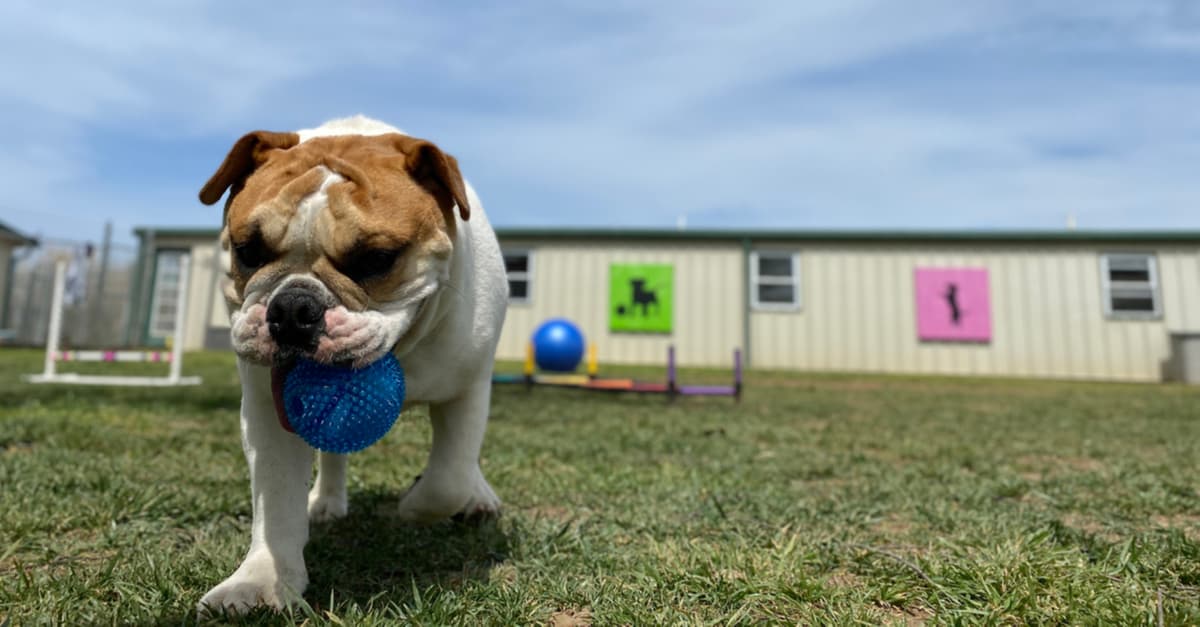
A beaball is energetic during play and may have an urge to bite while playing.
©Ryan Brix/Shutterstock.com
Even though this hybrid is energetic during play, it is still very easy to live with. These dogs may have a strong-willed streak because of their hunting background. Their hunting instincts are inherited from their beagle and English bulldog parents. They retain a strong urge to bite during play from their bulldog side, so you need to take care to discourage nipping early on.
Care
New beabull owners need to keep several important factors in mind when caring for this crossbreed, from how to deal with barking to their lifespan. Although every dog involves a commitment to provide care, a beabull has a stronger need to be around people more than some breeds. This must be kept in mind.
The factors unique to this hybrid include price, lifespan, shedding, and whether they are commonly available through rescue. Keeping these issues in mind before you commit to getting one of these dogs can help prevent a disappointing outcome.
Best Dog Food
As with any deep-chested dog breed, owners should carefully monitor their eating to make sure they don’t gobble their food too fast, or eat too soon before and after exercising. Beabulls, from puppies all the way through adulthood, have special dietary needs because of their background. There are a few things that new owners need to consider when buying food:
Beabull puppy food: High-quality puppy food fed in smaller meals will help your puppy avoid digestive problems. You may choose either wet or dry, or a combination of the two depending on your puppy’s preferences. A high-protein food will help your puppy avoid putting on too much weight. Chicken, turkey or fish-based foods will help fill this need.
Beabull adult dog food: Adult beabulls will also be well with a high-protein food, or have their food supplemented with lean meat. Feeding a diet higher in protein while minimizing fat and keeping carbohydrates at reasonable levels will help your dog avoid issues with obesity later in life and contribute to a longer lifespan.
To cater to this breed’s health, A-Z Animals believes the best dog food for Beabulls is Purina Pro Plan With Probiotics Shredded Blend High Protein, Digestive Health Adult Dry Dog Food.
Live probiotics for problem-free digestion make this food perfect for Beabulls, given their propensity for digestive disorders. Plus, high protein and a healthy balance of fat from real meat will satiate your dog’s generous appetite and thus help reduce overeating and excess weight. Also, a healthy digestive system translates to a robust immune system to prevent and fight infection. Natural glucosamine from real poultry and fish sustains beabulls’ joints, which can be vulnerable to degradation.
Follow this link to buy Purina Pro Plan Probiotics Shredded Blend High Protein Digestive Health Dog Food on amazon.
- High protein beef and rice formula dry dog food
- Probiotics to support digestive and immune health
- Vitamin A and omega-6 fatty acids for healthy skin and coat
Maintenance And Grooming
Beabulls will do most of their shedding during the spring and fall. Professional grooming is not likely to be necessary for this crossbreed, and a dog brush will help remove loose hair with a weekly brushing, except during shedding season when you may have to brush twice a week. Dogs might be susceptible to problems with their facial skin because of their wrinkles.
Training
Beabulls are easy to train, like their parent breeds, and owners will enjoy the process. Positive reinforcement plays a leading role in the success of raining for these dogs.
Exercise
Regular exercise, such as playing fetch or going for a walk, will help keep beabulls happy. Although these dogs can do well in apartments, a yard can provide more exercise opportunities. Daily walks are helpful, and time spent in the yard or at a dog park several times a week is also helpful.
Puppies

It is important to include socialization when training a beabull puppy so that it adjusts well to new people and things.
©Zerega/Shutterstock.com
Regardless of whether you acquire your beabull puppy from a rescue or a breeder, you need to make sure the puppy is at least eight weeks old. This age is also a good time to start housebreaking your puppy and discouraging behavior like nipping.
Getting your puppy used to as many new experiences as possible is essential for a well-adjusted dog. The more encounters your puppy has with new people and things, the less upsetting unfamiliar things will be.
Children
Beabulls are a breed unlikely to have aggression issues, making them excellent choices for families with children. Kids living with any type of dog need to understand how to treat the dog respectfully.
Similar Dogs
Other similar dog breeds to the beabull include meagles, Boston terriers, and cheagles.
- Meagles are similar to beagles because of their popularity as family pets, friendly nature, and overall friendliness to everyone.
- Boston terriers have a similar lovable temperament to beabulls and share a similar size.
- Cheagles share a tight bond with their family and a high activity level like the beabull.
Beabull FAQs (Frequently Asked Questions)
What is a Beabull?
A Beabull is a hybrid between the Beagle and the English Bulldog.
Are Beabulls aggressive?
Beabulls are not an aggressive breed. Aggression is due to poor socialization or cruel treatment.
What does a full grown Beabull look like?
When grown, a Beabull is the approximate size of a Beagle. It has some traits in common with English Bulldogs, such as facial wrinkles.
Are Beabulls healthy?
Beabulls are usually healthy dogs. They may inherit health issues from either the Beagle or English Bulldog side of their family.
How much do Beabulls cost?
The price to acquire a Beabull from a breeder may average between $1500 to $3000.
How much does it cost to own a Beabull?
In addition to the $1500 to $3000 initial cost, you must consider annual veterinary expenses. Wellness checkups average about $200 a year for this breed.
Are Beabulls good with kids?
Yes, although proper supervision is recommended.
How long do Beabulls live?
Beabulls live 10 – 13 years on average.
Thank you for reading! Have some feedback for us? Contact the AZ Animals editorial team.
Sources
- AKC, Available here: https://www.akc.org/expert-advice/health/hip-dysplasia-in-dogs/
- Pets.WebMD.com, Available here: https://pets.webmd.com/dogs/gastric-volvulus-bloat-dogs#1
- AKC, Available here: https://www.akc.org/expert-advice/training/puppy-training-timeline-teaching-good-behavior-before-its-too-late/





